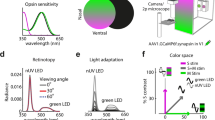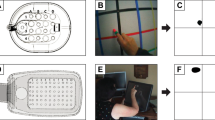Abstract
IT is usually considered that the outer portions* of photoreceptor cells of primate and other retinas behave as light pipes or waveguides1,2, each receptor preferentially accepting rays which are coaxial or nearly coaxial with the receptor's axis of cylindrical symmetry3. A receptor takes advantage both of a long axial path and of the planar orientation of its visual pigment molecules4–7 for maximal light absorption while at the same time confining light to one point in the retinal plane and in visual space. Preferential acceptance thus leads simultaneously to high sensitivity and to good angular resolution, for light detection.
This is a preview of subscription content, access via your institution
Access options
Subscribe to this journal
Receive 51 print issues and online access
$199.00 per year
only $3.90 per issue
Buy this article
- Purchase on Springer Link
- Instant access to full article PDF
Prices may be subject to local taxes which are calculated during checkout
Similar content being viewed by others
Change history
01 May 1968
In the communication "Photoreceptor Orientation in the Primate Eye" by Alan M. Laties, Paul A. Liebman and Charles E. M. Campbell (Nature, 218, 172; 1968) the second sentence of the fourth paragraph should read: "The lines D, Pn pass through each receptor axis at each point Pn. The magnitude of the deviation angle q1 included at the intersection of the axis line D, Pn and the radius line O, Pn is computed from the sine law .
References
Toraldo de Francia, G., Nuovo Cimento, 5, 589 (1948).
Enoch, J. M., in Fiber Optics (edit. by Kapany, N.), 5, 372 (Academic Press, New York, 1967).
Stiles, W. S., Ann. Roy. Coll. Surg. Eng., 30, 73 (1962).
Schmidt, W. J., Z. Zellforsch., 22, 485 (1935).
Denton, E. J., J. Physiol., 124, 16P (1954).
Brown, P. K., J. Opt. Soc. Amer., 51, 1000 (1961).
Liebman, P. A., Biophys. J., 2, 161 (1962).
Aguilar, M., and Plaza, A., Sociedad Espanol de Fisica y Quimica, 50, 119 (1954).
Cajal, S. Ramon y., Histologie du Système Nerveux de l'Homme et des Vertébrés, II (Inst. Ramon y Cajal, Madrid, 1955).
Polyak, S., The Vertebrate Visual System, 217 (University of Chicago Press, Chicago, 1957).
Wolff, E., The Anatomy of the Eye and Orbit, 94 (H. K. Lewis, London, 1958).
Laties, A. M., J. Optic. Soc. Amer., 57, 1426 (Abstract) (1967).
Laties, A. M., Tissue and Cell (in the press).
Author information
Authors and Affiliations
Rights and permissions
About this article
Cite this article
LATIES, A., LIEBMAN, P. & CAMPBELL, C. Photoreceptor Orientation in the Primate Eye. Nature 218, 172–173 (1968). https://doi.org/10.1038/218172a0
Received:
Issue Date:
DOI: https://doi.org/10.1038/218172a0
This article is cited by
-
Planar polarity in primate cone photoreceptors: a potential role in Stiles Crawford effect phototropism
Communications Biology (2022)
-
Realignment of cones after cataract removal
Nature (2001)
Comments
By submitting a comment you agree to abide by our Terms and Community Guidelines. If you find something abusive or that does not comply with our terms or guidelines please flag it as inappropriate.



